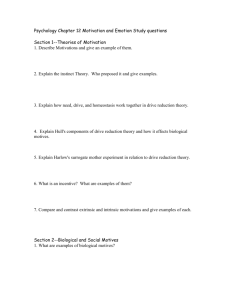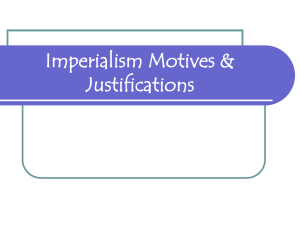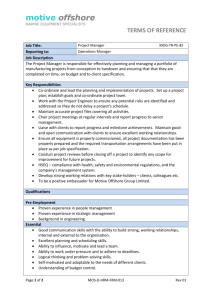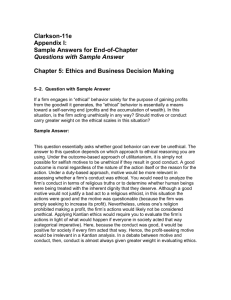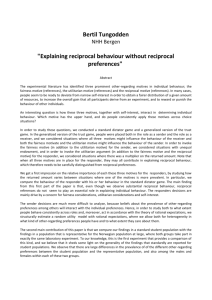Remarks on special values of L
advertisement
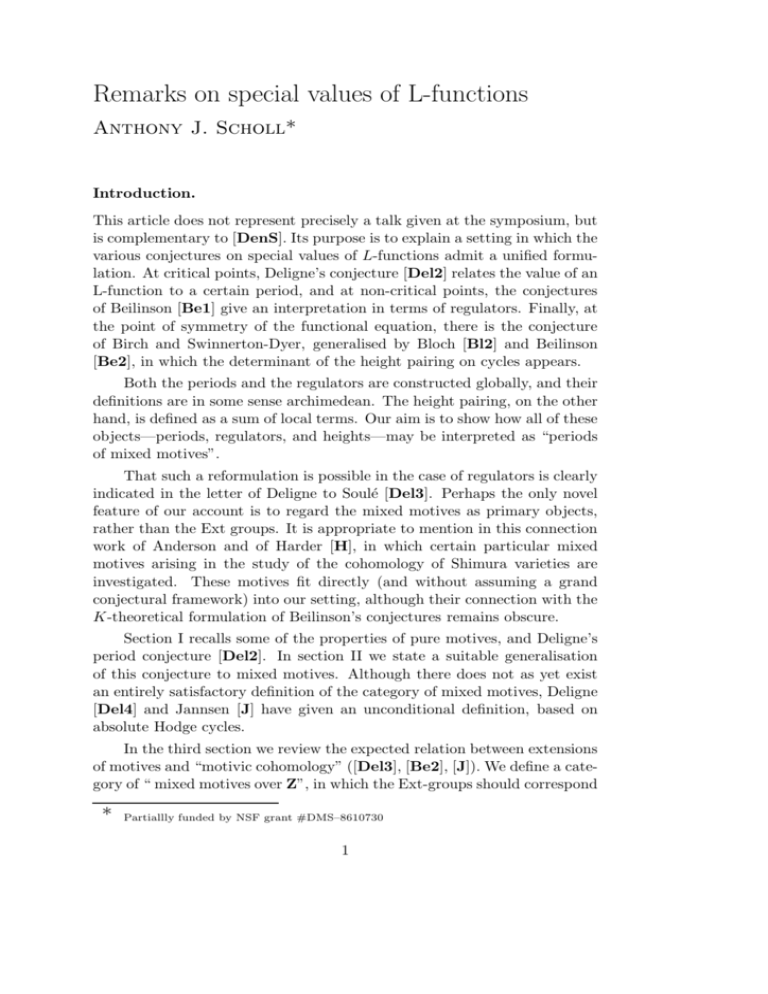
Remarks on special values of L-functions
Anthony J. Scholl*
Introduction.
This article does not represent precisely a talk given at the symposium, but
is complementary to [DenS]. Its purpose is to explain a setting in which the
various conjectures on special values of L-functions admit a unified formulation. At critical points, Deligne’s conjecture [Del2] relates the value of an
L-function to a certain period, and at non-critical points, the conjectures
of Beilinson [Be1] give an interpretation in terms of regulators. Finally, at
the point of symmetry of the functional equation, there is the conjecture
of Birch and Swinnerton-Dyer, generalised by Bloch [Bl2] and Beilinson
[Be2], in which the determinant of the height pairing on cycles appears.
Both the periods and the regulators are constructed globally, and their
definitions are in some sense archimedean. The height pairing, on the other
hand, is defined as a sum of local terms. Our aim is to show how all of these
objects—periods, regulators, and heights—may be interpreted as “periods
of mixed motives”.
That such a reformulation is possible in the case of regulators is clearly
indicated in the letter of Deligne to Soulé [Del3]. Perhaps the only novel
feature of our account is to regard the mixed motives as primary objects,
rather than the Ext groups. It is appropriate to mention in this connection
work of Anderson and of Harder [H], in which certain particular mixed
motives arising in the study of the cohomology of Shimura varieties are
investigated. These motives fit directly (and without assuming a grand
conjectural framework) into our setting, although their connection with the
K-theoretical formulation of Beilinson’s conjectures remains obscure.
Section I recalls some of the properties of pure motives, and Deligne’s
period conjecture [Del2]. In section II we state a suitable generalisation
of this conjecture to mixed motives. Although there does not as yet exist
an entirely satisfactory definition of the category of mixed motives, Deligne
[Del4] and Jannsen [J] have given an unconditional definition, based on
absolute Hodge cycles.
In the third section we review the expected relation between extensions
of motives and “motivic cohomology” ([Del3], [Be2], [J]). We define a category of “ mixed motives over Z”, in which the Ext-groups should correspond
*
Partiallly funded by NSF grant #DMS–8610730
1
to the integral part of motivic cohomology (coming from the K-theory of
regular schemes, projective over Spec Z). In the appendix to [DenS] some
evidence for this relation is described.
In sections IV and V we describe the consequences of the period conjecture in the case of certain particular mixed motives (“universal extensions”).
This shows how the conjecture includes the relevant parts of the conjectures
of Beilinson and Birch-Swinnerton-Dyer as special cases. The comparison
at the central point is somewhat more complicated than at the other points,
and we only give a sketch; more details will appear later [S].
In the final section we show, in answer to a question raised by Deligne,
that the period conjecture of section II contains no further information on
L-values than the existing conjectures. We also repeat the calculations of §5
of [Del2] to show that it is compatible with the functional equation. Thus
the period conjecture satisfies the most obvious consistency conditions.
An obvious gap in our account is the failure to allow motives with
coefficients other than Q. However we hope that it is apparent that the
same constructions can carried out be done word-for-word for motives with
coefficients. The other restriction we have imposed—that the ground field
be always Q—seems in contrast to be essential to our approach, mainly
because of the “peculiar” behaviour of the Riemann zeta function at s = 0
and s = 1.
As should be clear to the reader, this article is really only a naı̈ve
attempt to come to grips with Beilinson’s conjectures in a motivic setting,
and relies heavily on the ideas of [Be1], [Be2], [Del3] and [J]. I would
like to thank particularly Peter Schneider and Uwe Jannsen for stimulating
discussions and comments.
This article is an expanded version of talks given in the summer of 1988
in Luminy and Oberwolfach. The final version was completed during a stay
at the Institute for Advanced Study. It is a pleasure to thank them for their
hospitality.
2
I. Pure motives and Deligne’s conjecture.
We first recall the notion of a (pure, or homogeneous) motive. For the moment it will not be too important which category of motives we consider–
either Grothendieck motives (defined by algebraic correspondences modulo
homological equivalence), or Deligne’s category of motives defined by absolute Hodge cycles, would do. However in subsequent sections it will be
important that the realisation functors should be faithful—this being the
case in both categories mentioned, by construction. For simplicity we consider only motives defined over Q, with coefficients in Q.
Associated to a motive M over Q are its various realisations MB , Ml ,
MDR and the comparison isomorphisms
∼ M,
∼ M ⊗ C.
I : M ⊗ Q −→
I : M ⊗ C −→
l
B
l
l
∞
B
DR
M will be pure of weight w if the eigenvalues of an unramified Frobenius
Frobp acting on Ml have absolute value pw/2 , and if the Hodge filtration
induces a Hodge structure on MB which is pure of weight w. The example to
bear in mind is of course M = hi (X)(m), where X is smooth and projective
over Q, and w = i − 2m.
The L-function L(M, s) is the Euler product:
Y
L(M, s) =
L(p) (M, s)
where
p
I
L(p) (M, s) = det 1 − p−s Frobp |Ml p
−1
,
l 6= p
(conjecturally independent of l). We assume the existence of the meromorphic continuation and functional equation whenever necessary.
+
The period mapping I∞
is defined as the composite
MDR
∼ M ⊗ C −−−→
⊗R
→ MDR ⊗ R −−−→
→
MB+ ⊗ R ֒−→ MB ⊗ C −→
DR
F0
+
(this differs slightly from the notations of [Del2]). M is critical if I∞
is
an isomorphism. In this case its determinant is a well-defined element of
R∗ /Q∗ , denoted c+ (M ).
Deligne’s conjecture is that, for critical M ,
L(M, 0) · c+ (M )−1 ∈ Q.
Remarks. Deligne also conjectures that L(M, 0) 6= 0 if w 6= −1. We shall
return to this point later. Of course, the period c+ may be defined even
when M is not critical, but only satisfies a rather mild restriction (see [Del2]
§1.7), but for mixed motives this will not turn out to be the case. Finally
we remind the reader that the notion of being critical depends only on the
vanishing of certain Hodge numbers hpq , hp± .
3
II. Mixed motives.
If X is an arbitrary scheme of finite type over Q, then the cohomology
groups H i (X), with respect to either de Rham, Betti or l-adic theory, have a
natural filtration W· (the weight filtration), compatible with the comparison
isomorphisms and (in the case of l-adic cohomology) with the Galois action.
i
The weight filtration induces a mixed Hodge structure on HB
(X), and the
W
i
Galois modules Grj H (X ⊗ Q, Ql ) are pure of weight j.
We now require the existence of a category MMQ of mixed motives
over Q. (As mentioned in the introduction, such a category has been constructed by Deligne and Jannsen.) This is to be an abelian category, containing M as a full subcategory. To each mixed motive E will be associated
in a functorial way realisations EB , EDR , El . El is to be a finite-dimensional
representation of Gal(Q/Q), and EB , EDR finite-dimensional vector spaces
over Q, equipped with an involution Φ∞ and a decreasing filtration F· .
There will be comparison isomorphisms
∼ E,
Il : EB ⊗ Ql −→
l
∼ E ⊗ C.
I∞ : EB ⊗ C −→
DR
Finally there is to be an increasing filtration W · on EB , stable under Φ∞ .
The filtration induced (via Il ) on El is to be stable under the action of
Gal(Q/Q), and the graded pieces GrW
j El are to be pure Galois representations of weight j. The filtration induced (by I∞ ) on EDR ⊗ C is to be
defined over Q, and together with F · and Φ∞ is to define a mixed Hodge
structure over R. Lastly, the comparison isomorphisms Il are to take the
involution Φ∞ to complex conjugation in Gal(Q/Q).
We may define the L-function of a mixed motive E in the same way as
Q
for a pure motive—notice that in general L(E, s) and L(GrW
j E, s) will
differ by a finite number of Euler factors, as the passage to invariants under
inertia is not an exact functor. There is one obvious case in which we have
equality.
Definition. E is a mixed motive over Z if the weight filtration on El splits
over Qnr
p , for every l, p with l 6= p.
Remark. Presumably one should expect that for a given p this condition
need only be checked for one l.
The mixed motives over Z form a full subcategory MMZ of MMQ ,
containing M. They will play an important part in the next section.
If X is of finite type over Q, then there should be mixed motives hi (X)
in MMQ . In general they will not be motives over Z (see the example
below).
4
Returning to the case of an arbitrary mixed motive E, we define the
period map
EDR
+
+
⊗ R −→ 0 ⊗ R
I∞
: EB
F
in the same way as for pure motives.
+
Definition. A mixed motive E is critical if I∞
is an isomorphism. If this
+
+
holds, define c (E) = det I∞ .
Remark. It is obvious that if the pure motives GrW
j E are critical, then so
is E, but the converse is far from true. For mixed motives, the notion of
critical does not just depend on the Hodge numbers and the action of Φ∞ .
Conjecture A. If E is critical, then L(E, 0) · c+(E)−1 ∈ Q.
Example. (Trivial.) Let X be the singular curve obtained from Gm /Q
by identifying the points 1, p for some prime p. Then E = h1 (X)(1) is an
extension:
0 −→ Q(1) −→ E −→ Q(0) −→ 0
17→p
Here E is the 1-motive [Z−→Gm ], in the sense of Deligne [Del1]. It is easy
to see (using the explicit realisations of 1-motives given in loc. cit.) that
L(E, s) = ζ(s)ζ(s + 1)(1 − p−s)
so that L(E, 0) = − 21 log p. Moreover E is critical, and
+
c (E) =
Z
1
p
dt
.
t
So in this case Conjecture A holds. Notice that in this case we have obtained
the leading term of an incomplete L-function as a period.
5
III. Extensions of motives.
To discuss conditions under which a motive is critical, and to predict orders
of L-functions, we need Ext groups. Write ExtQ for the Ext groups in
MMQ , and ExtZ for the groups in MMZ . We should have ExtqQ = ExtqZ =
0 unless q = 0 or 1. If M , M ′ are motives over Z, then Ext0Q (M ′ , M ) =
Ext0Z (M ′ , M ) = Hom(M ′ , M ). Moreover Ext1Z (M ′ , M ) is the subgroup of
Ext1Q (M ′ , M ) comprising the classes of those extensions
0 −→ M −→ E −→ M ′ −→ 0
such that for every p and every l 6= p, the extension El of Galois modules
splits over Qnr
p . Conjecturally, the groups ExtZ will be finite-dimensional
over Q.
Suppose that X is smooth and proper over Q, and that M = hi (X)(m),
∼ hi (X)(n) with n = i + 1 − m. Then we should have
N = M ∨ (1) −→
Ext0Z (M, Q(1)) = Ext0Z (Q(0), N ) = Hom(Q(−n), hi (X))
0
if i 6= 2n
=
n
n
0
CH (X)/CH (X) ⊗ Q if i = 2n;
i+1
HM (X, Q(n))Z if i + 1 6= 2n
Ext1Z (M, Q(1)) = Ext1Z (Q(0), N ) =
CH n (X)0 ⊗ Q
if i + 1 = 2n.
Here CH n (X) is the Chow group of codimension n cycles on X modulo
rational equivalence, and CH n (X)0 is the subgroup of classes of cycles homologically equivalent to zero. HM denotes the motivic cohomology:
i
(X, Q(j)) = (K2j−iX ⊗ Q)(j)
HM
∗
∗
and HM
(X,··)Z is the image in HM
(X,··) of the K-theory of a regular model
for X, proper and flat over Z. The ExtQ groups will be the given by the
∗
∗
same rules, but with HM
(X,··)Z replaced by HM
(X,··). In the case i = 2n−1
1
1
the equality of the groups ExtZ and ExtQ would be a consequence of the
monodromy-weight filtration conjecture, which implies that any extension
of H 2n−1 (X ⊗ Q, Ql ) by Ql (n) splits over Qnr
p for every p 6= l.
In the case of the Tate motive, the above would imply that
Ext1Q (Q(0), Q(1)) = Q∗ ⊗Z Q;
Ext1Z (Q(0), Q(1)) = Z∗ ⊗Z Q = 0.
(The extension in the example of the previous section corresponds to p⊗1 ∈
Q∗ ⊗ Q.)
6
Although we are far from having a good category of mixed motives in
which the above isomorphisms hold, one can nevertheless unconditionally
associate to elements of HM -groups explicit extensions of cohomology arising from the cohomology of non-compact or singular schemes. For example,
let X be smooth and projective over Q, and let ξ be a cycle on X of codimension n, homologically equivalent to zero. If H( − ) denotes (say) l-adic
cohomology, then by pullback from the exact sequence
2n
0 −→ H 2n−1 (X)(n) −→ H 2n−1 (X − |ξ|)(n) −→ H|ξ|
(X)(n)
x
Q·ξ
one obtains an extension of Ql (0) by H 2n−1 (X)(n), whose class depends
only on the rational equivalence class of ξ—see [J], §9. The general case can
be treated in a similar way, using Bloch’s description of motivic cohomology
by means of higher Chow groups [Bl1]—see the appendix of [DenS] for a
sketch.
In this context, the regulator maps arise from the realisation functors.
For example, suppose that n > 2i + 1. Then it is shown in [Be2] that there
is a canonical isomorphism
∼ Ext1
i+1
i
HD
(X/R, R(n)) −→
R−Hdg (R, H (X)(n))
(where the second group is the Ext group in the category of real Hodge
structures with an infinite Frobenius) and the regulator should then fit into
a commutative square
∼
−→
Ext1Z (Q, hi (X)(n))
yrealisation
i+1
(X, Q(n))Z
HM
regulator
y
∼ H i+1 (X/R, R(n))
Ext1R−Hdg (R, H i (X)(n)) −→
D
The conjectures of Birch–Swinnerton-Dyer, Tate and Beilinson on the
orders of L-series at integer points can be simply stated in terms of Extgroups:
Conjecture B. Let E be a motive over Z. Then
ords=0 L(E, s) = dimExt1Z (E, Q(1)) − dim Ext0Z (E, Q(1)).
Remarks. (i) In the case of motives over Z both sides of this conjectural
identity should be additive in exact sequences, so the essential case of the
7
conjecture is for a pure motive—in which case it it simply a restatement of
the existing conjectures.
(ii) We can also write ExtqZ (E, Q(1)) = ExtqZ (Q(0), E ∨ (1)) to write the
order of L(E, s) in terms of the dual motive E ∨ (1), in accordance with the
principles of [Del3].
Now we can propose an algebraic criterion for a mixed motive to be
critical.
Definition. The mixed motive E over Z is highly critical if
ExtqZ (E, Q(1)) = ExtqZ (Q(0), E) = 0 for q = 0, 1.
Conjecture C. If E is highly critical, then it is critical.
IV. Motives with two weights.
It should be clear that, starting from an arbitrary motive M , one should be
able to construct some kind of “universal extension” by sums of Q(0) and
Q(1) to create a new motive E over Z which is highly critical, and whose
L-function is of the form
L(E, s) = ζ(s)?ζ(s + 1)? L(M, s).
Up to a nonzero rational, L(E, 0) will equal the leading coefficient of L(M, s)
at s = 0, and conjecture A will then be applicable to E. We now describe
the consequences of this, using the conjectural framework outlined above.
We first consider the case of a pure motive of weight w ≤ −2, which we
denote N . Since the weight filtration is increasing and M is supposed to
be semisimple we have
Ext1Q (N, Q(1)) = Ext0Q (Q(0), N ) = 0.
First assume that Hom(N, Q(1)) = 0, and let ρ = dim Ext1Z (Q(0), N ). Then
the universal extension
0 −→ N −→ N † −→ Ext1Z (Q(0), N ) ⊗ Q(0) −→ 0
will have ExtqZ (N † , Q(1)) = ExtqZ (Q(0), N † ) = 0 for q = 0, 1. (We are
using the expected vanishing of Ext1Z (Q(0), Q(1)).) Conjecture C therefore
implies that N † is critical. Let us examine its periods.
8
+
The period map I∞
(N ) is easily seen to be injective (from consideration
+
of the Hodge numbers) whereas I∞
(Q(0)) = 0. Therefore N † will be critical
if and only if the connecting homomorphism:
∂
N
Ext1Z (Q(0), N )−→
NDR ⊗ R
0
F NDR ⊗ R + NB+ ⊗ R
+
= coker I∞
(N )
becomes an isomorphism when tensored with R.
i+1
If N = hi (X)(n) and n > 1 + 2i then the first group is HM
(X, Q(n))Z,
i+1
the second group is HD (XR , R(n)) and the homomorphism ∂N is the
regulator map. The canonical Q-structure on the target of ∂N is the Qstructure Di,n (cf [DenS], (2.3.1)). Since L(N † , 0) = L(N, 0)ζ(0)ρ is a
non-zero rational multiple of L(N, 0), we see that conjectures A, B, C imply
Deligne’s reformulation ([Del3], [DenS] 3.1) of Beilinson’s conjectures for
L(hi (X), n).
Now consider a pure motive M of weight ≥ 0 with Hom(Q(0), M ) = 0.
Dually to the above, there is a universal extension
f −→ M −→ 0
0 −→ Q(1)ρ −→ M
f gives a connecting
where ρ = dim Ext1Z (M, Q(1)). The period map for M
homomorphism
+
∂M : ker I∞
(M ) −→ Rρ .
If we write N = M ∨ (1) then there is a canonical isomorphism
∼ ker I + (M )∨
coker I + (N ) −→
∞
∞
(compare [Del2], §5.1) in terms of which ∂M and ∂N are adjoint. Observe
that the highest exterior powers of both sides have a natural Q-structure.
However the isomorphism does not respect these Q-structures. In the case
N = hi (X)(n), M = hi (X)(i + 1 − n) the natural Q-structure on the right
hand side can be seen to be Beilinson’s Q-structure (Bi,n in the notations of
f) is Beilinson’s regulator. Since L(M
f, s) =
[DenS] 2.3.1). Therefore c+ (M
ρ
ζ(s+1) L(M, s), the conjectures imply that the leading coefficient of L(M, s)
f), and we recover the original
at s = 0 is a nonzero rational multiple of c+ (M
formulation of Beilinson’s conjectures ([DenS], 3.1.3).
If dim Hom(Q(0), M ) = σ > 0, then we should replace M by the quotient
M/Q(0)σ . Since ExtqZ (Q(0), Q(1)) = 0 for q = 1, 2 we have
∼ Ext1 (M/Q(0)σ , Q(1))
Ext1 (M, Q(1)) −→
Z
Z
f to be the universal extension of M/Q(0)σ by Q(1). This
and we take M
corresponds precisely to the “thickening” of the regulator which occurs in
the Beilinson conjectures at the near-central point (ie., m = i/2 and n =
1 + i/2).
9
V. Motives with three weights.
We now consider possible extensions of a motive M which is pure of weight
−1. Let G = Ext1Z (M, Q(1)) and G′ = Ext1Z (Q(0), M ). Then we obtain two
universal extensions:
0 −→ G∗ ⊗ Q(1) −→
0 −→
f
M
−→ M †
M
−→
M
−→ G′ ⊗ Q(0)
−→ 0
−→ 0
where G∗ = Hom(G, Q).
Assuming Ext1Z (Q(0), Q(1)) = Ext2Z (Q(0), Q(1)) = 0, there is a unique
mixed motive E over Z with
′
GrW
0 E = G ⊗ Q(0),
GrW
−1 E = M,
∗
GrW
−2 E = G ⊗ Q(1)
and GrW
j E = 0 for j > 0 or j < −2, such that
f,
W−1 E = M
E/W−2 E = M † .
Setting ρ = dimQ G, ρ′ = dimQ G′ , we find that E is highly critical and that
′
L(E, s) = L(M, s) · ζ(s + 1)ρ · ζ(s)ρ .
Now M is itself critical. Examining the period mapping for E shows
that conjecture C holds for E if and only if a certain connecting homomorphism
ΩM : G′ ⊗ R −→ G∗
is an isomorphism, and c+ (E) is then c+ (M ) · det ΩM .
Now consider the particular case M = h2n−1 (X)(n), n ≥ 1. In this
case we should have G′ = CH n (X)0 ⊗ Q, and G = CHn−1 (X)0 ⊗ Q. As a
first attempt to construct E, choose Y ⊂ X of codimension n and Z ⊂ X
of dimension n − 1 such that Y ∩ Z = ∅ and every cycle of codimension n
(respectively dimension n − 1) is rationally equivalent to a cycle supported
in Y (resp. Z). Then in any of the various cohomology theories, E ′ =
H 2n−1 (X − Y relZ)(n) has three nonzero steps in its weight filtration:
def
′
2n
0
2n
2n
GrW
0 E = HY (X) (n) = ker{HY (X)(n) −→ H (X)(n)};
′
2n−1
GrW
(X)(n);
−1 E = H
def
′
2n−2
GrW
(Z)0 (n) = coker{H 2n−2 (X)(n) −→ H 2n−2 (Z)(n)}.
−2 E = H
By choosing suitable maps G′ → HY2n (X)0 (n) and G ⊗ H 2n−2 (Z)0 (n) →
Q(1), and taking the associated pullback and pushout, we obtain an object
10
E ′′ with the correct graded pieces. The homorphism ΩE ′′ is essentially the
infinite component of the height pairing between cycles supported in Y and
in Z.
However E ′′ need not be a mixed motive over Z. The obstruction is
′
a certain element of Ext1Q (Q(0)ρ , Q(1)ρ ). If X satisfies some reasonable
hypotheses (essentially those required to define tha global height pairing)
this obstruction can be explicitly constructed in terms of local heights, and
17→p
can be realised as a suitable sum of 1-motives [Z−→Gm ], for various primes
p (as described at the end of §II). Therefore in order to obtain E itself we
must twist by the inverse of this obstruction. This will change the period
mapping by appropriate multiples of log p, and it turns out that ΩE is
the homomorphism attached to the complete height pairing (including the
contributions from the finite primes). Consequently:• Firstly, E is critical if and only if the global height pairing of BeilinsonBloch-Gillet-Soulé ([Be3] [Bl2] [GS])
< ·, · > : G ⊗ G′ −→ R
is non-singular;
• Secondly, if E is indeed critical, then
c+ (E) = c+ (h2n−1 (X)(n)) · det < > .
In other words, conjectures A, B and C imply the Beilinson-Bloch generalisation of the Birch-Swinnerton-Dyer conjectures.
It is possible to rewrite the construction of the extensions of this and
the previous section in a unified way in a (hypothetical) derived category
of motives, but we shall not attempt to describe this here.
Finally we remark here that one can consider the p-adic periods of
mixed motives in the same way as above. The essential point (which was
shown to me by U. Jannsen) is that if the l-adic realisations of a motive E
(pure or mixed) are unramified at p, then the p-adic representation Ep of
Gal(Qp /Qp ) should be crystalline. In this case there is then a p-adic period
map
EDR
+
Ip+ : EB
⊗ Bcris −→ 0 ⊗ Bcris
F
which should be an isomorphism if and only if E is critical. Now if we start
with a pure motive M whose l-adic realisations are unramified at p, the
same will be true of the various universal extensions constructed here. By
considering the associated period mappings, one then obtains Bcris -valued
regulators and height pairings. (These have been directly constructed by P.
Schneider.)
11
VI. Some compatibilities.
In this section we show that the only consequences of conjecture (A) are
those described above, and that the conjecture is compatible with the functional equation. In order to give the statements of the theorems below some
actual meaning, we will take for MMQ the category of mixed motives defined by absolute Hodge cycles, as considered by Deligne and Jannsen [J].
We will restrict our attention to motives whose l-adic realisations are independent of l, so as to be able to discuss L-functions, and we shall assume
the analytic continuation and functional equation for any L-functions that
may arise. Of the remaining desirable properties this category might enjoy,
we assume (only) the following:
Hypotheses.
(a) Ext1Q (Q(0), Q(1)) is generated by the classes of 1-motives of type (iv)
below.
(b) If M is pure of weight −1, then ords=0 L(M, s) ≥ dimExt1Z (M, Q(1)) =
dim Ext1Q (M, Q(1)).
(c) If M is pure of weight ≤ −2 then the realisation map Ext1Z (Q(0), M )⊗
R → Ext1R−Hdg (R(0), MR ) is injective.
The first hypothesis implies that Ext1Q (Q(0), Q(1)) = Q(S) where S
denotes the set of rational primes. Hypothesis (b) includes a weak form of
conjecture (B) for M . (See also III above.) Finally, (c) is equivalent to the
+
statement that I∞
(M † ) is injective, hence is a weak form of conjecture (C).
(The reader who is sceptical of the general finiteness of groups such as III
will be reassured that we do not require equality in (b).)
Theorem 1. Assume the truth of hypotheses (a)–(c) above. Let E be a
critical mixed motive over Q, with L(E, 0) 6= 0. Then there is a filtration
K· of E with the following properties:
∗
• The graded pieces Ei = GrK
i E are critical motives with L(Ei , 0) ∈ R ;
Q
•
L(Ei , 0) · L(E, 0)−1 ∈ Q∗ ;
• Each Ei is one of the following:
(i) An extension of a pure motive M of weight ≥ 0 by a sum of copies
of Q(1), with Hom(Q(0), M ) = 0;
(ii) An extension of a sum of copies of Q(0) by a pure motive M of
weight ≤ −2 with Hom(Q(1), M ) = 0;
(iii) A motive whose nonzero graded pieces in the weight filtration are
a sum of copies of Q(1), a pure motive of weight −1, and a sum
of copies of Q(0);
12
φ
(iv) The 1-motive [Z−→Gm ], φ(1) = p.
• In cases (i)–(iii) Ei is a motive over Z.
If x, y ∈ R, we write x ∼ y if x = ay for some a ∈ Q∗ .
Theorem 2. The hypotheses being as in Theorem 1, assume the truth of
conjecture 6.6 of [Del2] (that every motive of rank 1 and weight 0 is an Artin
motive). Suppose that L(E ∨ (1), 0) is also nonzero. Then L(E, 0)·c+ (E)−1 ∼
L(E ∨ (1), 0) · c+ (E ∨ (1))−1 .
Before giving the proofs, we make some general observations. We say
that a motive is supercritical (subcritical) if the period mapping is surjective
(injective). Suppose A → B → C is a short exact sequence of motives. Then
by applying the snake lemma to the ladder
A+
B ⊗R
y
F 0 \ADR ⊗ R
−→
+
BB
⊗R
y
−→ F 0 \BDR ⊗ R
−→
+
CB
⊗R
y
−→ F 0 \BDR ⊗ R
+
(C) ≥
we see that if B is supercritical, then C is supercritical and dim ker I∞
+
dim coker I∞ (A); there is a dual statement if B is subcritical.
We recall the conjectural analytic continuation and functional equation
of a (pure) motive. If A is pure of weight w and contains no direct factors
of Q(0) or Q(1) then the conjectures imply:
+
• If w ≥ 0 then A is supercritical and ords=0 L(A, s) = dim ker I∞
(A);
• If w ≤ −2 then A is subcritical and ords=0 L(A, s) = 0.
Now suppose that A is mixed of weight ≥ 0, and Hom(Q(0), A) = 0.
Q
Then as
L(GrW
q A, s) is the product of L(A, s) with a finite number of
+
Euler factors, we have ords=0 L(A, s) ≥ dimker I∞
(A); likewise if A is mixed
of weight ≤ −2 and Hom(A, Q(−1)) − 0 then ords=0 L(A, s) ≥ 0. In each
case equality holds if and only if the multiplicities of the eigenvalue 1 of
I
Frobp on Gr·W (Al )Ip and on Al p are equal.
Construction of the filtration. We first introduce a convenient notation.
By the symbol
A.k
..
A1
we mean any mixed motive with an increasing filtration (not necessarily the
weight filtration!) whose ith graded constituent is isomorphic to Ai .
13
By virtue of the weight filtration, and the fact that pure motives are
semisimple, we can write:
A
Q(0)d
E= N=
M
Q(1)e
B
where M is pure of weight −1 (and therefore critical), A is mixed of weight ≥
0 with Hom(Q(0), A) = 0, and B is mixed of weight ≤ −2 with Hom(B, Q(1))
= 0. Since E is critical, A and B are respectively supercritical and subcrit+
+
ical; let f = dim ker I∞
(A), g = dim coker I∞
(B). We have f + d = e + g.
By removing direct factors we can also write
′
′
N = Q(0)d ⊕ Q(1)e ⊕ M ′ ⊕ C
with
q′
X = Q(0)
M′ =
M
′′
=Y
Q(1)q
,
C=
Q(0)m
Q(1)n
and Hom(Q(0), X) = Hom(Y, Q(1)) = Hom(Q(0), C) = Hom(C, Q(1)) = 0.
By hypothesis (a), the extension C is classified by some
φ = (φp ) ∈ Hom(Qm , Qn )(S) = Ext1Q (Q(0)m , Q(1)n ).
Kummer theory gives an isomorphism
∼ Hom(Qm , Qn );
Ext1Ip (Ql (0)m , Ql (1)n ) −→
l
l
under this isomorphism, the representation Cl of the inertia group at p is
n
classified by the homomorphism φp : Qm
l → Ql .
Proposition. Let Rp denote the rank of φp . Then:
P
(i) ords=0 L(C, s) =
Rp − n;
(ii)
P
p∈S
Rp ≥ max(m, n);
p∈S
(iii) If C is critical and L(C, 0) 6= 0 then C =
L
17→p
p
Proof. (i) Consider the short exact sequence
0 −→ Ql (1)n −→ Cl −→ Ql (0)m −→ 0
14
Rp
[Z−→Gm ]
.
of Ip -modules. Rp is the dimension of the image of the boundary homomorphism
Ql (0) −→ Ext1Ip (Ql (0)m , Ql (1)m )
and therefore equals the codimension of the image of (Cl )Ip in Ql (0)m .
Therefore the Euler factor of L(C, s) at p is
1 − p−1−s
whence
−n
1 − p−s
L(C, s) = ζ(s)mζ(s + 1)n
Y
Rp −n
1 − p−s
p
Rp
and (i) follows.
(ii) Write U = Qm , V = Qn . Since Hom(Q(0), C) = Hom(C, Q(1)) = 0,
the homomorphisms
x7→(φp (x))
φ′ : U −−−−−→ V (S)
x7→(t φp (x))
and φ′′ : V ∗ −−−−−−→ (U ∗ )(S)
attached to the classifying map φ are injective. Since the images of these
are contained in the subspaces
M
M
t
φp (U ) ⊂ V (S) ,
φp (V ∗ ) ⊂ (U ∗ )(S)
p
p
we have the inequality (ii).
(iii) The period mapping for C is
X
log p · φp : U ⊗ R −→ V ⊗ R.
p∈S
P
If C is critical and
L(C,
0)
is
nonzero,
m
=
n
=
RL
p . In this case the image
L
of φ′ is precisely
φp (U ), hence we can write U = Up in such a way that
p
p
φp factors through the projection:
M
φp : U =
Up −→
→ Up ֒−→ V.
For
P
log p·φp to be an isomorphism we must therefore have V =
L
φp (Up ),
p
which implies (iii).
Now let q = ords=0 L(M, s). By hypothesis (b) for M and the properties
of M ′ we have q ′ , q ′′ ≤ q. Also the conjectural analytic continuation and
functional equation give
ords=0 L(A, s) ≥ f
and
15
ords=0 L(B, s) ≥ 0.
Because of the decomposition of N we can rearrange the filtration on E as:
A
′
′
A
=
Q(1)e
M′ ⊕C
.
E=
′
Q(0)d
B ′ =
B
Then A′ is supercritical and B ′ is subcritical. Therefore f ≥ e′ and g ≥ d′ ,
with equality if and only if A′ and B ′ are critical, respectively. This gives
0 ≥ ords=0 L(E, s)
≥ ords=0 L(A′ , s) + ords=0 L(M ′ , s) + ords=0 L(C, s) + ords=0 L(B ′ , s)
X
≥ (f − e′ ) + (q − q ′′ ) + (
Rp − n) + 0
≥ 0.
Therefore L(E, 0) 6= ∞, and L(E, 0) is nonzero if and only if f = e′ , q = q ′′
P
and
Rp = n. Then
X
Rp = n = e − f − g = d − g − q ≤ d − d′ − q ′ = m.
p∈S
By part (ii) of the proposition, this implies also g = d′ , q = q ′ , m = n.
Therefore A′ and B ′ are critical. Hence so are M ′ and C. By part (iii)
of the proposition, C is a sum of motives of type (iv). Moreover we have
ords=0 L(M ′ , s) = 0. Now by hypothesis (b)
ords=0 L(M ′ , s) ≥ ords=0 L(Y, s) ≥ ords=0 L(M, s) + q ≥ 0
and the first inequality is an equality only if the extension of Ip -modules
Yl → Ml → Ql (0)q splits. Also the hypothetical equality of Ext1Z (M, Q(1))
and Ext1Q (M, Q(1)) shows that the extension Ql (1)q → Yl → Ml splits over
Ip , hence M ′ is a motive over Z of the type (iii).
It finally remains to analyze the motives A′ and B ′ . Consider first B ′ .
By the above we have ords=0 L(B ′ , s) = 0. Moreover as Hom(B ′ , Q(1)) = 0
′
we have ords=0 L(B, s) ≥ 0. Consider the extension Bl → Bl′ → Ql (0)d1
of modules under the inertia group at p 6= l. Since the local Euler factors
for Q(0) each have a pole at s = 0, this extension must split (otherwise
L(B ′ , 0) would vanish). Now let w be the highest weight of B, and write
B1 = GrW
w (B), Z = Ww−1 (B). Then
n
B1
B=
Z
16
and we can then rewrite B ′ as:
′
Q(0)d1
′
′
′
d
d
B
=
′
′
Q(0) 1
Q(0)
1
B1
Q(0)d −d1 ⊕
′
B =
=
=
B
B
′
′
1
1
Q(0)d −d1
′
Z
Z
Z =
Z
Continuing in this way we obtain a filtration:
′
B
.1
d′i
′
′
.. , B = Q(0)
B =
i
Bi
′
Br
P ′
where each Bi is pure, Hom(Q(0), Bi′ ) = 0, and
di = d′ . By the above,
each Bi′ is a motive over Z, so is a submotive of the universal extension Bi†
of section IV. The hypothesis (c) implies that Bi† is subcritical. Therefore
each Bi′ is subcritical, hence critical (since B ′ itself is critical).
Now consider A′ . In the same way we can write
′
A
.1
Ai
′
′
.
′
A =
. , Ai =
Q(0)ei
′
At
P ′
with Ai pure, Hom(A′i , Q(1)) = 0, and
ei = e′ . Now
+
ords=0 L(Ai , s) = fi = dim ker I∞
(A′i )
Therefore ords=0 L(A′i , s) ≥ fi −e′i , with equality if and only if the (Frobp =
1)-eigenspace of (A′i,l )Ip maps onto that of (Ai,l )Ip . In view of the exact
sequence
′
′
(Ai,l )Ip −→ (A′i,l )Ip −→ H 1 (Ip , Ql (1)ei ) = Ql (0)ei
this holds if and only if A′i is a motive over Z.
Now
0 = ords=0 L(A′ , s) ≥
X
ords=0 L(A′i , s) ≥
X
(fi − e′i ) = f − e′ = 0,
so we must have equality at each stage. Therefore each A′i is a motive over Z,
fi . So by hypothesis
and therefore is a quotient of the universal extension A
(c) each A′i is supercritical, and therefore also critical. Also e′i = fi , whence
L(A′i , 0) ∈ R∗ . This concludes the proof of Theorem 1.
17
Proof of Theorem 2. Recall the definition of the constant δ(M ) ([Del2],
1.7.3); we extend this definition to mixed motives as well. The proof of
Proposition 5.1 of [Del2] then gives:
Proposition. Let E be a critical (mixed) motive. Then E ∨ (1) is also
critical, and
−
c+ (E) · c+ (E ∨ (1))−1 ∼ (2πi)−d (E) · δ(E)
−
).
(where d− (E) = dimEB
Now suppose that E satisfies the hypotheses of the theorem. Write
L (−) for the leading coefficient in the Laurent expansion of L(−, s). By
the proof of Theorem 1, we have
∗
L(E, 0) = L∗(E) =
Y
L∗ (GrW
q E) ·
q
Y
(log p)Rp
p
and likewise
L(E ∨ (1), 0) = L∗ (E ∨ (1)) =
Y
∨
L∗ (GrW
q E (1)) ·
q
Y
(log p)Rp .
p
It therefore suffices to prove that for any pure motive M of weight w
−
L∗ (M ) · L∗ (M ∨ (1))−1 ∼ (2πi)−d
(M )
· δ(M )
which by under our assumptions (as in 5.6 of [Del2]) is equivalent to
−
L∗∞ (M ) · L∗∞ (M ∨ (1))−1 ∼ (2π)d
(M )+ 21 wd(M )
.
This in turn is a trivial extension of Proposition 5.4 of [Del2].
18
References
[Be1] A. A. Beilinson; Higher regulators and values of L-functions. J. Soviet Math. 30 (1985), 2036–2070.
[Be2] A. A. Beilinson; Notes on absolute Hodge cohomology. Applications
of algebraic K-theory to algebraic geometry and number theory
(Contemporary Mathematics 55 (1986)), 35–68.
[Be3] A. A. Beilinson; Height pairing on algebraic cycles. Current trends
in arithmetical algebraic geometry, ed. K. Ribet (Contemporary
Mathematics 67 (1987)), 1–24.
[Bl1]
S. Bloch; Algebraic cycles and higher K-theory . Advances in Math.
61 (1986) 267–304.
[Bl2]
S. Bloch; Height pairing for algebraic cycles. J. Pure Appl. Algebra
34 (1984), 119–145.
[Del1] P. Deligne; Théorie de Hodge III. Publ. Math. IHES 44 (1974),
5–78.
[Del2] P. Deligne; Valeurs de fonctions L et périodes d’intégrales. Proc.
Symp. Pure Math. AMS 33 (1979), 313–346.
[Del3] P. Deligne; Letter to C. Soulé. 20–1–1985.
[Del4] P. Deligne; Le groupe fondamental de la droite projective moins
trois points. Galois groups over Q (ed. Y. Ihara, K. Ribet, J.-P.
Serre). MSRI publications 16, 1989 .
[DenS] C. Deninger, A. J. Scholl; The Beilinson conjectures. This volume.
[GS]
H. Gillet, C. Soulé; Intersection sur les variétés d’Arakelov. C.R.A.S.
t.299, sér.1, 12 (1984), 563–566.
[H]
G. Harder; Arithmetische Eigenschaften von Eisensteinklassen, die
modulare Konstruktion von gemoschten Motiven und von Erweiterungen endlicher Galoismoduln. Preprint, 1989.
[J]
U. Jannsen; Mixed motives and algebraic K-theory. Lecture notes
in math. 1400 (1990).
[S]
A. J. Scholl; Height pairings and special values of L-functions. In
preparation.
19

